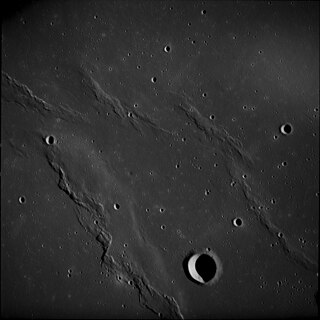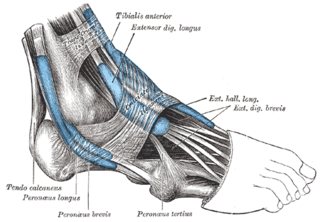
A wrinkle ridge is a type of feature commonly found on lunar maria, or basalt plains. These features are low, sinuous ridges formed on the mare surface that can extend for up to several hundred kilometers. Wrinkle ridges are tectonic features created after the lava cooled and solidified. They frequently outline ring structures buried within the mare, follow circular patterns outlining the mare, or intersect protruding peaks. They are sometimes called veins due to their resemblance to the veins that protrude from beneath the skin.

The extensor digitorum longus is a pennate muscle, situated at the lateral part of the front of the leg.

The extensor digitorum brevis muscle is a muscle on the upper surface of the foot that helps extend digits 2 through 4.

The extensor hallucis brevis is a muscle on the top of the foot that helps to extend the big toe.
Calliprora is a genus of moths in the family Gelechiidae.
The Naedyceras group comprises three similar and closely related openly coiled, gyroconic, genera within oncocerid family, Brevicoceratidae: Naedyceras, Gonionaedyceras, and Gyronaedyceras.
Calliprora rhodogramma is a moth of the family Gelechiidae. It is found in Brazil (Amazonas).
Calliprora tetraplecta is a moth of the family Gelechiidae. It is found in Peru.
Calliprora platyxipha is a moth of the family Gelechiidae. It is found in Brazil.
Calliprora eurydelta is a moth of the family Gelechiidae. It is found in Peru.
Calliprora erethistis is a moth of the family Gelechiidae. It is found in Peru.
Calliprora peritura is a moth of the family Gelechiidae. It is found in Brazil (Para).
Calliprora pentagramma is a moth of the family Gelechiidae. It is found in Guyana.
Calliprora sexstrigella is a moth of the family Gelechiidae. It is found in North America, where it has been recorded from Arizona, California, New Mexico and Texas.
Eudactylota abstemia is a moth of the family Gelechiidae. It is found in North America, where it has been recorded from Arizona.
Eudactylota diadota is a moth of the family Gelechiidae. It is found in North America, where it has been recorded from Arizona.
Eudactylota iobapta is a moth of the family Gelechiidae. It is found in Mexico and the United States, where it has been recorded from Arizona and Texas.
Eudactylota barberella is a moth of the family Gelechiidae. It is found in Mexico and the United States, where it has been recorded from Arizona, Colorado and New Mexico.
Stenoma tristrigata is a moth of the family Depressariidae. It is found in Brazil and the Guianas.

Notothenia trigramma is a species of marine ray-finned fish, belonging to the family Nototheniidae, the notothens or cod icefishes. It occurs in the southwestern Atlantic Ocean.




